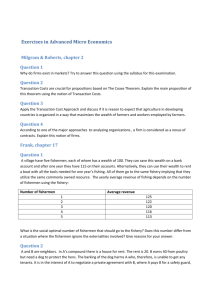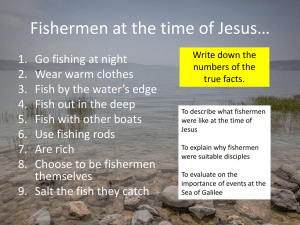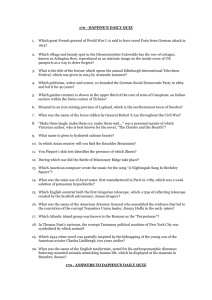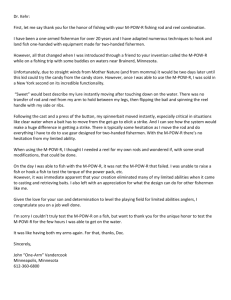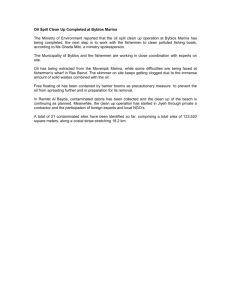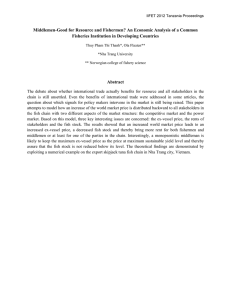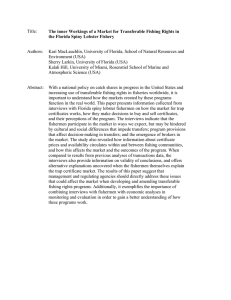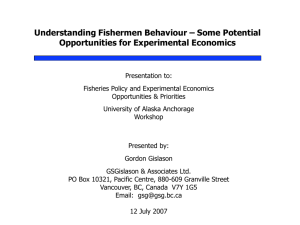! "#$%&'()!#*+$,#'*+! "-.!/011.234!56!2-.!781.!"95:3;81!#.<509;.<!&4<23202.!
advertisement
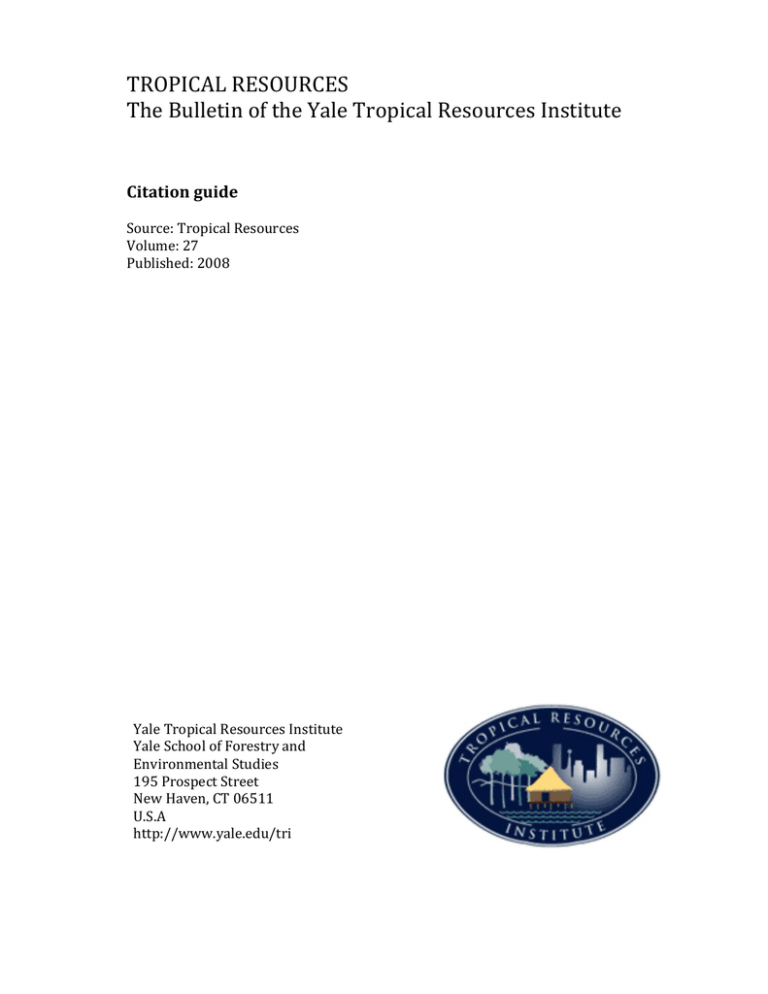
! ! "#$%&'()!#*+$,#'*+! "-.!/011.234!56!2-.!781.!"95:3;81!#.<509;.<!&4<23202.! ! ! ! ! "#$%$#&'!()#*+! ! +509;.L!"95:3;81!#.<509;.<! N510A.L!OP! %0Q13<-.?L!OIIR! ! ! ! ! ! ! ! ! ! 781.!"95:3;81!#.<509;.<!&4<23202.! 781.!+;-551!56!=59.<29>!84?!! *4@3954A.4281!+20?3.<! BCD!%95<:.;2!+29..2! E.F!G8@.4H!'"!IJDBB! ,K+K(! -22:LMMFFFK>81.K.?0M293!! ! ! ! ! ! ! ! ! Market Values of the Commercial Fishery on the Madeira River: Calculating the Costs of the Santo Antônio and Jirau Dams to Fishermen in Rondônia, Brazil and Pando-Beni, Bolivia by Erin Barnes, MEM 2007 Problem The Madeira River begins in the Andes, flows through the floodplain of the Bolivian Amazon, runs over forty-two waterfalls, becomes navigable at Porto Velho—the furthest inland port in Brazil—and finally meets the Amazon River near Manaus. It is the longest tributary of the Amazon River with the largest sediment load of the basin. Brazil’s current hydroelectric development plan is hinged on building two dams on the Madeira River at seasonal waterfalls, Santo Antônio and Jirau (Figure 1). The dams are part of the Integration of South America’s Regional Infrastructure, or IIRSA, a joint project by the Inter-American Development Bank, the Andean Development Corporation, and the UN Development Programme. The project has an estimated construction cost of about US $8 billion. Unfortunately Brazil’s overall economic analysis does not include secondary costs such as those of electricity transmission, forced relocation, increased malarial rates, land conversion from rainforest to savannah and methane gas releases in the reservoir. Erin Barnes completed an undergraduate degree in English and American Studies at the University of Virginia. She subsequently worked as the Public Information Officer at Save Our Wild Salmon Coalition before starting a Master’s of Environmental Management at Yale. During the MEM program she co-founded SAGE Magazine and co-organized the Global Perspectives on Large Dams conference. She works for Men’s Journal as assistant editor of environmental affairs. 60 Volume 27, Spring 2008 Nor does the Environmental Impact Assessment (EIA) (Furnas et al. 2005) by IBAMA—Brazil’s environmental protection agency—enumerate the economic benefits of the project, like increased navigation and soy exports. This study seeks to measure the market value of the Madeira River fishery between Porto Velho, Brazil, and Trinidad, Bolivia, in order to estimate one of many costs of the hydroelectric project. It relies on survey results from a small sample, so the results should be treated as trends and indications of the local market. Further studies are needed to more precisely measure the value of the commercial and noncommercial fisheries. Scope The Brazilian Institute of Environment and Renewable Natural Resources (IBAMA) defined the area impacted by the dam project based on the predicted area of inundation caused by the dams. Other studies consider the impacts of the project to be broader. Jorge Molina (2006) describes a larger stretch of flooding predicted to impact Bolivia. Dams cut off migratory fish populations from upstream communities first, but downstream populations can also be negatively impacted. Dams impact different fish species in different ways, favoring some and negatively affecting others, but it is predicted that the dams at Santo Antônio and Jirau will decrease fish populations overall and could threaten certain species with extinction (Barthem and Goulding 2006). Additionally, Market Values of the Commercial Fishery on the Madeira River periods of time and then asked to describe the average catch of typical species during typical months. The ownership and replacement of a boat and motor has been equated to an annual rent using the equation R = (p/r)/(1-e^-rt) with interest at four percent. This equation for rent was used based on the survey responses on the average life of the boats. The rate of replacement of boats was found to be 10 years. The total costs for each fisherman were calculated according to the following equation: Figure 1. Location of the affected fisheries along the Madeira River. Source: PCE, Furnas, Odebrecht 2004 because a significant number of the culturally important fish are migratory, fisheries biologists expect the impacts of the project to extend past the political borders (Van Damme 2006). Given the limitations in the scope of the research and in the available data, this paper focuses primarily on the area above Porto Velho and below Guajará-Mirim in Brazil. Ecosystem impacts will extend far beyond these boundaries, so the findings are likely to be conservative. TC = R (boat, motor) + E + Mc + Mbm + Cf Where R = annual rent of boat and motor E = equipment (nets, spears, lines, etc) Mc = annual membership to the fishermen’s association Mbm = reported annual maintenance costs to the boat, motor Cf = weekly costs of fishing x number of weeks fished per year OR Cf = weekly costs of fishing x number of weeks fished per year Some of the participants in the study had invisible costs because they were employed on boats on which the owner covered all costs. The average net market values of individual boats and fishermen were calculated by estimating and summing the different costs and revenues of fishermen. Those were then used to calculate the aggregate net market value of the fishery. Methods Description of the market Face-to-face surveys from May through August 2006 provided the data to estimate net incomes of fishermen. Of the surveys taken from representative communities of varying size and distance from the river, 22 samples were used. The survey measured the revenues and costs of both individuals and boats as entities. Survey participants were first asked about earnings, costs and net incomes over different Porto Velho and Guajará-Mirim are the major natural ports, home to larger scale commercial fishermen. These areas are more populous and dense. In addition both ports are geographically advantageous for fishing, located either near several cachoeiras, or waterfalls, or at the confluence of several rivers. So, the larger scale commercial fishermen with larger boats, more fishermen per boat, and longer fishing Tropical Resources Bulletin 61 Erin Barnes trip distances are at these opposite ends of the studied river stretch. As a result, these fishermen generally have larger catch and higher costs. But these fishermen have the fishermen’s colonia, an association that assists them in the sale of their catch, setting a price per kilogram that depends on supply. They can also purchase fishing supplies at these locations. Between the ports are many small settlements such as Cachoeira Teotônio, Jacy-Paraná, Nova Mamoré, Vila Murtinho and Jirau. These are frequently surrounded by smaller settlements of five or ten families living in wooden shacks. These groups—generally referred to as ribeirinhos, or river-dwellers—typically live at or above subsistence-level by fishing and farming manioc and harvesting bananas. They usually have small motor boats or canoes and their trips rarely exceed one day. Fishing is often a family activity and boats are shared casually among community members. Among ribeirinhos fish sale is less organized, with fishermen acting as both fisher and seller. Most fishermen own large coolers and will sell fish directly to the consumer on the street or from their homes. In many families, the father and older sons will fish and other family members will sell fish from home. Only during peak catch will small-scale fishermen in these small settlements travel in groups, by boat or by taxi, to Porto Velho or Guajará-Mirim to sell the large supply of fish. Inconsistencies in historic data First, there is a major inconsistency in the estimated number of fishermen in the impacted area. The fishermen’s associations Z-1 (Porto Velho) and Z-2 (Guajará-Mirim) have paying members of commercial fishermen: Z-1 reports a total of 2,325, between registered members and estimated non-registered fishermen; Z-2 estimates 1,500 fishermen. Through personal interviews, counting, and extrapolations, I estimate 1,000 fishermen in the region between these two hubs, but there is no official data for that stretch of the river. Yet the report in the EIA (data by Doria et al. 2005) uses 230—the number of fishermen they surveyed—as the total number for the entire stretch of the river. The study acknowledges they underestimate the real number, but chose to do so to avoid double counting (Furnas et al. 2005: IV-894). The second major inconsistency is in the annual fish harvest. Variations due to migration and El Niño patterns are natural, but no consistent studies have been done. The average annual fishery production for the entire stretch in question using all data is 703 tons (Figure 2). Figure 2. Tons of fish produce on the impacted stretch of the river. Source of data: Furnas et al. 2005 62 Volume 27, Spring 2008 Market Values of the Commercial Fishery on the Madeira River Figure 3. Comparison of Reported Incomes and Calculated Incomes, regressed on catch per boat (USD). Z-1 Fishermen’s Association data is consistently higher than that of the Doria et al. studies (Z-1 Colonia 2004, 2005). Higher recorded tonnage for Porto Velho than for the whole river indicates either an overestimate of the catch by the Fishermen’s Association or an underestimate by the Doria et al. studies. Either way, the discrepancy highlights the need for accurate studies with standard methods for collecting samples and measuring fish production. Third, because the sediment load of the Madeira River is so massive, there is little historic data from rivers of comparable size to predict the impacts on a river of this scale. Similarly, fish migration, feeding and spawning cycles remain unknown for many species despite the abundance of good research. As a result, the estimated percentage of fish loss used in this study is little more than a placeholder multiplier until that prediction is available. Results and discussion Reported net income and net income based on reported catch differed in Bolivia where the dearth of fish was described as a natural variation in the water levels of streams connecting the mainstem rivers to the breeding lagoons. In Brazil, the small fishermen’s reported and calculated incomes were fairly similar, with discrepancies increasing with the fishing scale. It is possible that the survey cannot detect some of the costs of large-scale professional fishermen with many employees, or that monthly fluctuations in catch are too wide for a survey to capture an accurate annual catch per large-scale fishermen. However, using average annual catch per large-scale fisherman from the Doria et al. (2005) study (17.655 tons/year) as a multiplier, calculated and reported incomes are much closer. The trendlines for relationships between total net income based on reported and calculated catch and between personal annual reported revenue and catch have R-squared values of 0.7414 and 0.8156 respectively (Figure 3). The calculated best estimate for the value of the fishery is conservative, and is more an indication than an exact measurement. This report is limited in its scope, as it included only data for commercial fishermen between Porto Velho and the Bolivian border, excluding noncommercial subsistence or barter fishermen. It is also limited geographically, focusing only on the stretch of the river directly impacted by the dams and their reservoirs, and not on the indirect impact of migration. Tropical Resources Bulletin 63 Erin Barnes Table 1. The present value of average incomes specific to certain regions, because fishermen near major cities have higher incomes than rural fishermen (USD). Region Brazil, Porto Velho Brazil, Madeira River, Stretch Between Brazil, Guajará-Mirim Average Net Annual Personal Income (USD) 11,119 Number of Fishermen Per Region 2,325 Aggregate Annual Income per Region (USD) 25,852,215 Present Value (PV = A/r) 2,961 4,118 1000 1500 2,960,602 6,177,104 Total 34,989,921 74,015,061 154,427,589 Total 874,748,019 A discussion of total present values of fisheries by region rather than on averages across the basin is more accurate (Table 1). Because its fishermen are upstream of the dams and are likely to be cut off from migratory species first, the impacts to Bolivia’s fishery should be evaluated. Based on comparisons of local fish markets, it is clear that the value of the same fish species in Bolivia and Brazil is equivalent in 2006 US dollars. Bolivia’s tributaries of the Madeira are home to approximately 1,000 fishermen, so we could place a present value of approximately $126,446,000 on Bolivia’s upstream tributaries of the Madeira. Similarly, we can conclude a present value of $379,338,000 downstream of the dam, using 3,000 as the approximate number of fishermen downstream of Porto Velho on the Madeira and the Lower Amazon. 646,305,368 Incorporating the values of the fishery beyond the directly impacted stretch of the river results in a present value ranging from an estimated low end of US$0.8 billion (Rs$1.9 billion) to a high end of $1.3 billion (Rs$2.8 billion) (Tables 2 and 3). Depending on what losses are incurred to the fishery by the hydroproject, the costs will change. The potential costs assuming a 12 percent loss to the fishery are $159 million, or $663 million assuming a 50 percent loss to the fishery (Table 4). Non-market values Participants were asked to answer some willingness-to-pay, or contingent valuation, questions. Many did not understand the questions, but of the one third who answered all pos- Table 2. Present value of the fishery based on averages including Bolivia and downstream regions of Brazil (USD). Region Average Net Annual Personal Income (USD) Bolivia, Upstr. Madeira 5,058 Brazil, Low End 5,058 Upstr. Madeira High End 5,058 Brazil, Downstr. Madeira & Amazon 5,058 Number of Fishermen Per Region 1000 2853 4825 3000 Low High 64 Volume 27, Spring 2008 Aggregate Annual Present Value Income per (PV = A/r) Region (USD) 5,057,838 126,445,947 14,430,011 360,750,287 24,404,068 610,101,694 15,173,514 Total 34,661,363 44,635,419 379,337,841 Total 866,534,075 1,115,855,482 Market Values of the Commercial Fishery on the Madeira River Table 3 . Present value of the fishery based on regional averages, including Bolivia and downstream regions of Brazil (USD). Region Average Net Annual Personal Income (USD) Bolivia, Upstr. Madeira 2,849 Brazil, Porto Velho 11,119 Brazil, Madeira River, Stretch Between 2,961 Brazil, Guajará-Mirim 4,118 Brazil, Downstr. Madeira & Amazon 5,058 Number of Fishermen Per Region 1000 2,325 Aggregate Annual Income per Region (USD) 2,848,800 25,852,215 Present Value (PV = A/r) 1000 1500 2,960,602 6,177,104 74,015,061 154,427,589 3000 15,173,514 Total 50,163,434 379,337,841 Total 1,325,305,867 itively expressed they would be willing to pay to stop the dam construction. Many were unable to construct a numeric value, but those who did ranged from US$28 to “all that I have.” One participant said he would pay monthly dues if a union were set up to protect the community. In fact, all fishermen currently pay monthly dues of about US$5 in membership fees to the fishermen’s colônia, an association set up to protect their interests. This aggregate fee could be used as a metric of a trend that shows some willingness to pay. When regressed, there is some positive dependence on the following variables: location on the river, education on dam impacts and level of income based on the fishery. More contingent valuation analysis is needed to determine a firm estimate of regional willingness to pay. 71,220,007 646,305,368 Conclusion large enough that it deserves further research to determine a more exact measurement. Only by correctly estimating the full costs and benefits of the hydro-project, can an economically efficient policy be made. The construction costs of the Madeira River hydroelectric project are close to US$8 billion. Yet the project puts a whole fishery worth as much as US$1.3 billion at risk, with the most commercially and culturally valuable fish, the dourada and big catfish, bound to incur the worst harm. Not only will this uncalculated economic loss cause an inefficient policy decision; but also, the loss of a fishery this size will upset the ecosystem and harm the communities that depend on them for a source of food and income. The negative impacts to these communities are disproportionately high, whereas the benefits of the project will be seen primarily outside the impacted region. Although this is a conservative indication of the value of the fishery, clearly that value is Note: All monetary units are expressed as US $2006. Table 4. Relative costs of potential losses to the fisheries (USD). Averaging 2853 over the Region 4825 Averages by Specific Region Size of Fishery Loss 50% 33% 433,267,037 259,960,222 557,942,741 334,765,645 662,652,934 437,350,936 20% 173,306,815 223,177,096 265,061,173 12% 103,984,089 133,906,258 159,036,704 Tropical Resources Bulletin 65 Erin Barnes Acknowledgements Funded by the International Rivers Network, the Yale Tropical Resources Institute, the Yale F&ES Globalization Fund and the Carpenter-Sperry Fund. References Barthem, R.B and M. Goulding. 2006. Pareceres dos Consultores sobre o Estudo de Impacto Ambiental do Projeto para Aproveitamento Hidrelétrico de Santo Antônio e Jirau, Rio Madeira - RO, Parecer Técnico Sobre a Ictiofauna. Furnas, Odebrecht e Leme. 2005. Sumário dos Estudos de Impacto Ambiental (EIA) Tomo B. Diagnóstico Ambiental Capítulo IV. Área de Influência Direta dos Aproveitamentos Hidrelétrico Jirau e Santo Antônio, Part 5 of 8. IBAMA. Doria, C. et al. Fundação Rio Madeira (RIOMAR), Instituição de Apoio à Universidade Federal de Rondônia (UNIR). 2005. Estudo de viabilidade das AHE’s Jirau e Santo Antonio, localizadas no Rio Madeira em Rondônia, no trecho entre Porto Velho e Abunã. Relatório Técnico Final, Componente: Ictiofauna e Pesca. Porto Velho/RO. Resumo Executivo. Molina, J. Análisis de los Estudios de Impacto Ambiental del Complejo Hidroeléctrico del Rio Madera: Hidrología y Sedimentos. La Paz, Bolivia, Abril 2006. Paul Van Damme, Executive Director, Faunagua. Personal communication, Cochabamba, Bolivia, July 2006. PCE, Furnas, Odebrecht. 2004. Complexo hidroelétrico do rio Madeira, Estudos de Viabilidade do AHE Jiray. Nov. 2004, Brasil. PCE, Furnas, Odebrecht. 2004. Complexo hidroelétrico do rio Madeira, Estudos de Viabilidade do AHE San Antônio. Nov. 2004, Brasil Z-1 Colonia de Pescadores, Porto Velho. Data for 2004 and 2005. Retrieved in person at the Colônia in Porto Velho, June 2006. Source: http://www.oldbookillustrations.com/index.php?lng=en 66 Volume 27, Spring 2008
